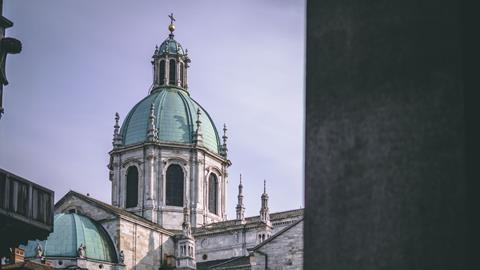Protestant Christian and apologist Nick Peters explores some key distinctions within different branches of Christianity
From the very beginning Christianity had divisions. We see this in the first epistle to the Corinthians where, in the first chapter, Paul talks about people saying they follow different people: some Apollos and some Paul and others claiming to only follow Christ.
In Church history, there have been two great divisions in the Church. The first was the Great Schism in 1054 that divided the Orthodox and the Catholic Churches. The next was in 1517 with the Reformation that led to the Protestant Churches.
The purpose of this article is not to criticise or praise any one branch, but rather to define the differences. Full disclosure: I myself concede to being a convinced Protestant, but still consider these other churches to represent brothers and sisters in Christ.
While the history could be discussed, my aim is not to show how the three branches came about, but how they are different. Before doing that, it is beneficial to look at what unites all three. All branches would hold to the four great Church councils: Nicea, Constantinople, Ephesus and Chalcedon. Beyond those four councils, varying amounts of disagreement follow.
Read more:
Catholic vs Protestant debate - “Should Christians pray to Mary?”
How a Protestant became Catholic and a Catholic turned Protestant
Catholics have questions
Does the Catholic Church need to modernise?
Common features
All branches would hold to truths like the Trinity, the deity of Christ, the resurrection of Jesus and that salvation is found in Christ. There are different canons of scripture, but all would at least agree to the usual Protestant canon, which are the books listed by Athanasius in his letter describing the canon.
All would also affirm the virgin birth, but Catholics and Orthodox Christians normally hold to perpetual virginity, that Mary never had intercourse.
Differences
Areas of disagreement include, to some extent, ideas about salvation. Although most churches do seem to agree, for the most part, that other members are in communion with Jesus. Also subject to conflict are the nature of baptism and the role of tradition. All churches value the teachings of the fathers of the Church, but Catholics and Orthodox Christians lean towards tradition being on par with scripture.
I don’t think all members of the Catholic or Orthodox Churches are Christians, but neither are all Protestants. We all have nominal members and devoted members. It is also worth considering the major contributions that each church has brought to the body.
The Catholic Church
While all churches claim to have their roots in the apostles and their teaching, Catholics tend to look at Jesus building his church on the rock, referring to Peter, and tell us that Jesus came to build a church. They hold the Pope as the Vicar of St Peter. Every Pope is said to be continuing in the line of St Peter then to lead the Church.
The metaphysics of the Catholic Church has largely been influenced by Thomas Aquinas, a figure many Protestants, like myself, also admire. The Church holds that one can pray to saints, angels and Mary. They also hold to transubstantiation, whereby the elements of the Eucharist (The Lord’s Supper or Communion) become the actual body and blood of Christ.
One of the great contributions that the Catholic Church has made is in the area of moral philosophy. They are staunch defenders of the pro-life position and the pro-marriage position. Many great philosophers who address questions of abortion, the nature of marriage and other ideas of natural law are Catholics. Naturally, not all such philosophers are Catholic, but a sizable number are.
Get access to exclusive bonus content & updates: register & sign up to the Premier Unbelievable? newsletter!
The Orthodox Church
The Orthodox Church is highly liturgical. Frequently in the West, a Catholic church building is not significantly different from a Protestant church building, however when one enters an Orthodox church, one cannot help but notice the difference immediately. Orthodox Christians say they are worshipping the same way the early Church did in many ways. Naturally, there are some differences, as many Orthodox churches do have electric lighting, air conditioning etc.
Orthodox churches are also loaded with images referred to as ‘icons’. These icons are pictures to remind the faithful of Jesus, the apostles and fathers, and the other various saints in Church history.
The Orthodox Church holds to many of the same beliefs as the Catholic Church, but in different ways. They would agree on the importance of scripture and tradition and the views on the Eucharist, but disagree as to which traditions. They do not hold to a Pope, but they do have their own ruling body.
One of the great contributions of the Orthodox Church is in daily living and practice. The Orthodox Church makes much of wisdom and its application to daily Christian life. Many a Protestant and Catholic could greatly benefit by reading Orthodox thought and putting into practice many of the teachings that are found therein.
The Protestant Church
Finally, we get to the Protestant Church, which also claims to have its foundation in the apostles. The Protestant Church does value the teachings of the fathers, but does not see them as infallible in any way. Instead, what is seen to be infallible is scripture. This is something referred to as ‘Sola Scriptura’. However, some Protestant thinkers are starting to go a different route. Sola Scriptura has led too many people to think “only scripture and no other sources”. Now some are saying ‘Suprema Scriptura’, which is a way of saying that, while not the only source of knowledge or wisdom, scripture is the supreme authority to which all others are held accountable.
Another great emphasis of the Protestant Church has been justification by faith alone. This doesn’t mean that ‘works’ do not matter. The saying is: “The faith that saves alone is never alone.” A true faith will work itself out in good works.
Protestants do not hold to one man, aside from Jesus, as a supreme authority or to any one governing body.
The great contribution that has come about through Protestant churches is highly in-depth research and study into the Bible. This is not to deny that Catholics and Orthodox do this, but a lot of great Bible commentaries and works of scholarship come from the Protestant Church. Also, Protestants have the great figure of CS Lewis, who is often loved by both Catholics and Orthodox Christians as well.
At this time in history, thankfully, there is coming to be more and more unity in our disagreements. I once made regular visits to an Orthodox church and still have friends from that community. I also attend a weekly meeting to go through the Summa Theologica of Thomas Aquinas and consider myself a Thomist in my philosophy and metaphysics.
As said, while I disagree on many issues with Catholics and Orthodox Christians (and a lot of Protestants as well), I am happy to count them as brothers and sisters in Christ.
Nick Peters has mentored under apologists Michael Licona and Norm Geisler and currently attends seminary, pursuing a degree in philosophy. Nick has Asperger’s Syndrome, a high-function form of autism, which has become a guiding force in his ministry to disabilities within the Church. Nick’s apologetics focus is on the historical Jesus, biblical scholarship and evidence for the resurrection.


























